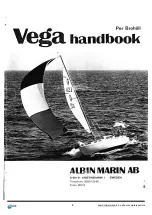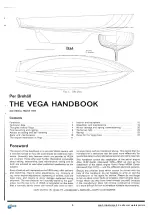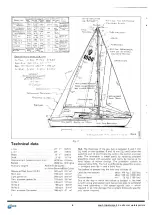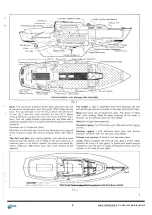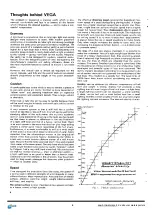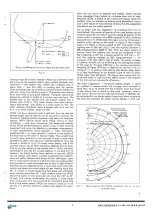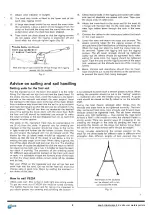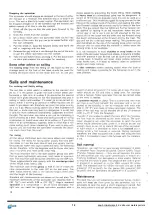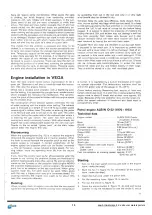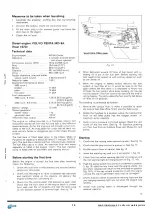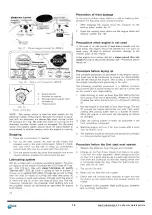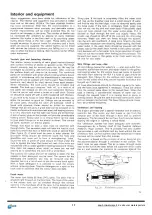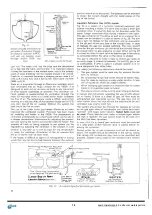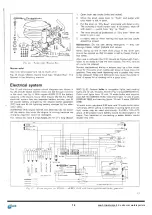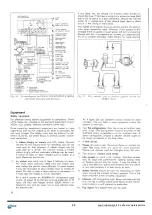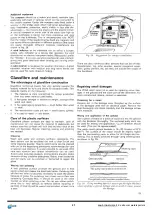
Thoughts behind VEGA
The p r o b l e m in d e s i g n i n g a cruising y a c h t w h i c h is e c o -
nomical, c o m f o r t a b l e and fast is to assess all the f a c t o r s
w h i c h influence the d e s i r e d qualities — and to make a suc-
cessful c o m p r o m i s e .
Economy
A light b o a t is e c o n o m i c a l . Not so long ago, light and s t r o n g
designs w e r e e x p e n s i v e to make. W i t h m o d e r n g l a s s f i b r e
c o n s t r u c t i o n it is p o s s i b l e to make light and strong m o u l d i n g s
at a l m o s t t h e same price per pound as heavy mouldings. The
price p e r p o u n d of a c o m p l e t e sailing y a c h t is j u s t a f r a c f i o n
higher f o r a light boat than a heavy boat. C o n s e q u e n t l y it is
p o s s i b l e t o d a y to build a roomy boat w h i c h is light in relation
to the v o l u m e — giving more boat f o r t h e money. Naturally,
the y a c h t has to be d e s i g n e d for m o d e r n , industrial m a n u -
f a c t u r e . From the d e s i g n e r ' s point of v i e w , d i s r e g a r d i n g the
m a n u f a c t u r e r ' s industrial and selling e f f i c i e n c y , t h e s e are
the m o s t i m p o r t a n t f a c t o r s to achieve t o e n s u r e a l o w initial
price.
H o w e v e r , the annual cost is almost as important f o r the
owner. U p k e e p , y a r d bills and the cost of sails etc are almost
d i r e c t l y p r o p o r t i o n a l to the w e i g h t of the yacht ( d i s p l a c e -
ment).
Comfort
A c o m f o r t a b l e boat is one w h i c h is easy to handle, a pleasure
to o w n a n d , above all, roomy. C o m f o r t is more dependet on
" e l b o w r o o m " and standing headroom than on i n g e n i o u s
a c c o m m o d a t i o n and e q u i p m e n t details. Thus a large v o l u m e
is d e s i r a b l e .
If t h e b o a t is light she w i l l be easy t o handle because t h e r e
will be small w e i g h t s to handle and small sails will be c a r r i e d
in relation t o the size.
A v e r y c o m m o n o p i n i o n is that a stiff huil has a q u i c k e r
motion at sea than a less stiff huil. In small sailing yachts the
steadying effect of the sails makes this a purely academie
o p i n i o n . Long e x p e r i e n c e of sailing in the o p e n sea has taught
me that there is almost no difference in the sea k i n d l i n e s s
of a light, stiff boat and that of a heavy, n a r r o w boat. There
is so much p o w e r in the seas that they can give large sailing
vessels a rather quick motion r e g a r d l e s s of t h e huil s h a p e .
F u r t h e r m o r e , it is more comfortable to sail at a small angle
of heel and in a boat w h i c h does not ship a lot of water. M o r e
important than the a t h w a r t s h i p s motion is t h e longitudinal
motion if t h e boat p o u n d s heavily. C o m p a r i n g the V E G A in
a test w i t h a much heavier offshore c r u i s e r of a well k n o w n
type, s h o w e d that the latter pounded much more and s h i p p e d
more w a t e r at the same s p e e d . The only boat w h i c h has been
sailed single handed t w i c e round the w o r l d , " I s l a n d e r " sailed
by P i d g e o n , had a v e r y stiff, hard chine huil. M y conclusions
are that f o r normal cruising — often in s h e l t e r e d w a t e r s —
a light, stiff boat is as g o o d or better t h a n a heavier boat.
C a t a m a r a n s are the ultimate in this d i r e c t i o n ; they have been
used for long ocean passages but there are other p r o b l e m s
— w h i c h is another story.
Speed
If we d i s r e g a r d the p r o p u l s i v e f o r c e (the sails), the s p e e d of
a sailing boat in different strengths of w i n d depends on many
different f a c t o r s . M o s t important are: A r e a and form of w e t t e d
s u r f a c e ; effective w a t e r l i n e length; w e i g h t ( d i s p l a c e m e n t ) ;
huil l i n e s ; and stability.
The wetted surface is most important at low speeds and also
to a lesser extent at high speeds.
The e f f e c t i v e Waterline length g o v e r n s the theoretical max-
imum s p e e d of a boat (disregarding planing hulls). A longer
boat has a higher maximum speed than a s h o r t e r one. H o w -
ever, a light boat can achieve a higher speed than a s l i g h t l y
longer b u t heavier boat. Thus displacement affects s p e e d . If
one w a n t s a fast craft it has to be made light. This holds t r u e
for aircraft, cars, bicycles, ships and motor boats, so w h y not
for sailing boats? It is no mere chance that " d i s p l a c e m e n t "
is placed b e l o w the line in speed equations for motor b o a t s .
Only w h e n weight increases the ability to carry sails, t h u s
increasing the propulsive f o r c e s , does it — in a limited sense
— p r o m o t e speed.
The lines of a boat are always important. It is possible to
make the underwater lines of a light w e i g h t boat sleeker than
those of a heavy displacement boat, thus p r o m o t i n g s p e e d .
Even if relatively high f r e e b o a r d and short overhangs d e c i e v e
the eye, t h e lines of V E G A are inherited f r o m the s k e r r y
cruisers. This purely S w e d i s h type of boat is considered (like
the Scandinavian Viking ships) to be one of the most h i g h l y
d e v e l o p e d and beautiful types of boat ever c o n c i e v e d . The
skerry cruisers developed according to a measurement rule
which neither restricted nor g o v e r n e d the development of t h e
huil lines. This resulted in a speedy huil. The basic lines of
V E G A have been drawn w i t h o u t c o n s i d e r i n g any measure-
ment rule.
Stability can be achieved by different combinations of huil
form and weight. A beamy, shallow huil produces a long
righting arm at a small angle of heel and even in a light boat,
a large righting moment can be obtained — initial stability.
A deep, narrow huil w i t h a deep ballast keel has a small
righting moment at small angles of heel, but at greater a n g l e s
the righting moment increases. The desired stability charac-
STAfcluTETSnOMEMT
12001
Fig.5. V EG A's stability curve.
4
6


